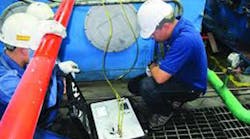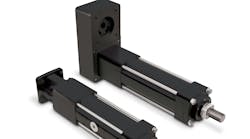How NOT To Go Down The WRONG Rabbit Hole When Hydraulic Troubleshooting
One of our members wrote me about the following problem:
"I wonder if you could help shine some light on a problem I am having with my railroad club locomotive. It is a 1/8th scale, gasoline-hydraulic driven unit. Up until a few months ago the locomotive was able to pull 10 heavy cars up a 2% grade without any problem. Recently however, the locomotive began making noises and jerky movements. Today I watched the three driven axles in the front of the engine and the three driven axles in the rear. They both behaved the same way.
When the locomotive was pulling the train on level ground there was no problem. But when the train began pulling the 2% grade the jerking began and I noticed that the hydraulic motor shafts (one driving each set of three axles using chains) did not turn smoothly. This is the source of the jerking effect. I thought the hydraulic fluid may be low so I checked the tank and found that it was nearly full but I was able to add another 1 gallon of hydraulic oil.
The locomotive was built and delivered in 2004. The motors are low rpm, high torque type. No maintenance has been performed on them since manufacture. Same for the pump. What are the failure modes of hydraulic motors and pumps that might give me a clue as to which is the most likely suspect? The motors are easy to remove and inspect while the pump is a real problem to get access to."
If you'd like a little challenge, pause your reading here and take a moment to consider the problem described above and jot down how would advise this member to proceed, and why.
Ready? Good. Now read on...
Every troubleshooting assignment begins, one way or another, with a bunch of information you're given. Some of it will be fact. Some of it will be opinion. Some of it will be fiction. How you sift and process this information determines which rabbit hole you go down first. Moreover, how SYSTEMATICALLY you sort this initial information will determine whether you go down the CORRECT rabbit hole first. And this is VERY important if you're to get a fast and accurate diagnosis.
So with this in mind, I'm not going to wing it. I'm going to begin the process by referring to the checklist on page 83 of The Hydraulic Troubleshooting Handbook. Question #1 on this checklist inquires of me: What conclusions can be drawn considering the symptoms of the problem in relation to the physical laws of hydraulics? This interrogation prompts me to review chapter 1 which explains the 7 physical laws as they relate to troubleshooting.
After doing this, the most sensible conclusion I can come to is the described symptoms (jerky, intermittent drive) are NOT consistent with a typical HYDRAULIC problem. Yes, any type of fault is possible. But this does not make it probable. And probabilities are important when troubleshooting.
Next, question #2 on the checklist inquires of me: Based on the above conclusions, what diagnostic tools are most appropriate and are they available to you? This interrogation prompts me to review chapter 2 which covers diagnostic tests. But I don't need to at this point. Because we're not ready for any diagnostic tests at this stage. Reason being, I want to fully explore my suspicion that this is NOT a hydraulic problem.
So I move on to question #3, which asks me: Have you carefully considered and listed all the easy things to check? And this interrogation prompts me to review chapter 3, which among other things contains a list of 15 items which should always be checked BEFORE reaching for any diagnostic tools. Number one on this list is: Level of oil in the tank. And our member has already checked this, which is good.
Also on this list is: The coupling between prime mover and pump; and between motor and final drive. So now, based on the information available, AND my systematic processing of it with the aid of The Hydraulic Troubleshooting Handbook, I've determined this is the rabbit hole we should go down first.
Since the motors on this machine are more easily accessible than the pump, I wrote back to this member and advised him to check the mechanical coupling, key, sprocket, etc. between the hydraulic motors and wheels; and between the pump and engine--in that order.
A couple of days later he wrote back:
"I performed a pull test on the locomotive and found the problem. As you suspected, the problem was not hydraulic. One of the drive chain sprockets had its teeth worn down to nubbins. If the load was low enough the chain would stay in place on the sprocket. But when higher loads were applied, the chain jumped from one nubbin to another thus causing the jerk."
The almost natural, automatic reflex when confronted with the detail of this problem is to assume it is hydraulic. And imagine the PAIN if you did: breaking into the system, losing oil, finding the adapters to install a flow-meter, the work involved in removing the motors and gaining access to the pump. Only to figure out eventually it was the chain drive.
No, you don't want to go down the wrong rabbit hole if you can avoid it. And this is just one of the reasons why The Hydraulic Troubleshooting Handbook is such a valuable tool: it stops you from jumping to conclusions and then going down the wrong rabbit hole.
PLUS as demonstrated above, it keeps bringing you back to the 12 key PRINCIPLES of troubleshooting that always ensure you get the correct diagnosis in the shortest possible time. Without it, your path from problem to correct resolution is likely to be unreliable, more time consuming and costly.
Learn more about The Hydraulic Troubleshooting Handbook here

